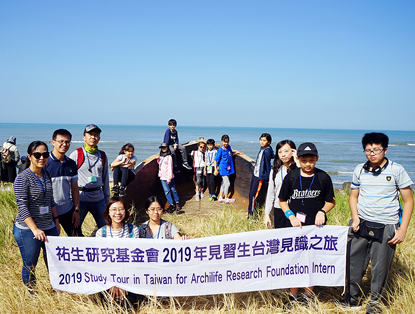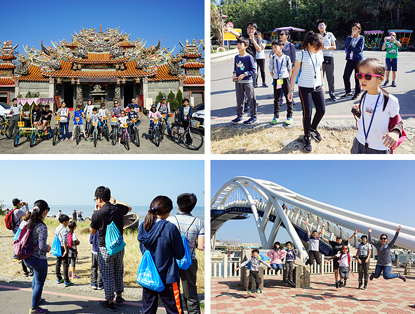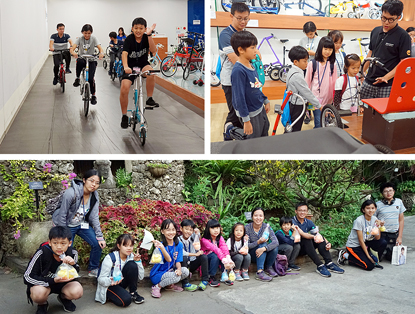Sketch of Archilife Study Tour, November 2019
|
2019年11月份見識之旅縮影  11月份見識之旅活動,於2019年11月16日由呂明澐小姐帶領12位祐生見習生及家長們,進行桃園新屋自行車發展暨雅聞香氛樂活之旅。出發當日天氣晴朗,見習生們及其家長皆準時集合並出發。活動開始之初,領隊呂明澐小姐提醒本次活動注意事項及觀察重點,先行建立見習生的背景知識。 11月份見識之旅活動,於2019年11月16日由呂明澐小姐帶領12位祐生見習生及家長們,進行桃園新屋自行車發展暨雅聞香氛樂活之旅。出發當日天氣晴朗,見習生們及其家長皆準時集合並出發。活動開始之初,領隊呂明澐小姐提醒本次活動注意事項及觀察重點,先行建立見習生的背景知識。For the study tour of November 16, 2019, Ms. Lu Ming-yun led 12 ARF interns and their parents to learn about the development of bicycles and enjoy a LOHAS trip in Taoyuan. It was clear and sunny on the day of the tour, and the interns and their parents were on time for the departure. At the start of the day's activities, team leader Ms. Lu Ming-yun reminded everyone about things to note and what to observe, and gave the interns some background knowledge.  本次上午行程於新屋綠色隧道進行自行車騎乘導覽。新屋一帶腹地廣闊,早期因戰略考量,國軍在此修築戰備道路,並於兩側種植濱海植物,以掩護軍隊蹤跡,隨著兩岸情勢趨緩,綠色隧道轉為觀光用途。行程之初,由太平洋自行車博物館人員帶領大家沿著綠色走廊往返永安漁港。導覽人員沿途介紹新屋地區海景地貌,特別指出該地素有「海上長城」之稱的石滬群。石滬係昔日利用潮汐捕魚的漁法,漁民在潮間帶上以石塊堆砌長堤,漲潮時魚群順著海水進入,退潮後因石堤高於海面,魚群洄游受阻而困於滬內,便可牽網捕撈漁獲。新屋早期靠海維生的居民,就地取材以人力搬運鵝卵石,幾乎動員全村之力,才能堆砌出上百至上千公尺的石堤,不僅體現前人協力互助的精神與智慧,更說明人們與大自然相互依存的關係,現今看來尤為珍貴。 本次上午行程於新屋綠色隧道進行自行車騎乘導覽。新屋一帶腹地廣闊,早期因戰略考量,國軍在此修築戰備道路,並於兩側種植濱海植物,以掩護軍隊蹤跡,隨著兩岸情勢趨緩,綠色隧道轉為觀光用途。行程之初,由太平洋自行車博物館人員帶領大家沿著綠色走廊往返永安漁港。導覽人員沿途介紹新屋地區海景地貌,特別指出該地素有「海上長城」之稱的石滬群。石滬係昔日利用潮汐捕魚的漁法,漁民在潮間帶上以石塊堆砌長堤,漲潮時魚群順著海水進入,退潮後因石堤高於海面,魚群洄游受阻而困於滬內,便可牽網捕撈漁獲。新屋早期靠海維生的居民,就地取材以人力搬運鵝卵石,幾乎動員全村之力,才能堆砌出上百至上千公尺的石堤,不僅體現前人協力互助的精神與智慧,更說明人們與大自然相互依存的關係,現今看來尤為珍貴。The morning's itinerary was a bicycle trip at Xinwu Green Tunnel. Xinwu covers a vast area. In the early days, due to strategic considerations, the military constructed a road for defense purpose and planted coastal plants on both sides of the road to cover the army's track. As the tension between Taiwan and China eases, the Green Tunnel has been converted for tourism use. Led by the staff of Pacific Cycles Museum, the morning began with a round trip to Yongan Fishing Port. The tour guide introduced Xinwu's ocean view and pointed out the stone weirs known as the "Great Wall of the Sea". The stone weirs are ancient tidal fish traps. Fishermen would build stone walls by stacking rocks in the intertidal zone. During high tides, fish would swim in along with the seawater and when the tide went out, the fish would get trapped within the walls as the walls were higher than sea level. In the early days, locals depending on the sea for their livelihood had to manually move cobblestones to build hundreds, even thousands, of meters of stone walls. A single stone weir would require the labor of a whole village. Not only does it show the pioneers' wisdom and teamwork, it is also evident of the interdependent relationship between mankind and nature.  中午飯後,前往太平洋自行車博物館參訪。導覽開始前,眾人先行觀賞館方介紹影片,認識該館設立目的及特色。影片播畢後,導覽人員解說自行車大小輪徑之差異,小輪徑所需的驅動力小,騎起來省力;大輪徑因驅動力大,剛開始會較費力,但騎乘至一定速度時,輪圈會產生向前驅動的慣性,故達到一定速度後,會較小輪徑輕鬆。爬坡路段因大輪徑一直無法達到慣性驅動速度,小輪徑相對輕鬆,但也因輪圈較小,腳踏一圈前進的距離不如大輪徑遠。隨後進行試乘體驗,其中不乏為特殊族群打造之自行車,眾人在體驗之餘,亦能認識不同車種的主要用途,如手搖車即專為平時較難從事戶外活動的身心障礙者設計。緊接著至館藏區進行介紹,導覽人員透過館內展示不同樣貌的自行車,說明腳踏車演進歷史及功能變化,起初主要做為單純的代步工具,隨著近年來綠色環保與健康意識抬頭,發展至今成為政府推動節能減碳及民眾日常休閒運動不可或缺的重要工具,自行車運動蔚為風潮。至此,本日活動已近尾聲,大家一起合照留念後搭車返程,並期待於下次見識之旅再相見。 中午飯後,前往太平洋自行車博物館參訪。導覽開始前,眾人先行觀賞館方介紹影片,認識該館設立目的及特色。影片播畢後,導覽人員解說自行車大小輪徑之差異,小輪徑所需的驅動力小,騎起來省力;大輪徑因驅動力大,剛開始會較費力,但騎乘至一定速度時,輪圈會產生向前驅動的慣性,故達到一定速度後,會較小輪徑輕鬆。爬坡路段因大輪徑一直無法達到慣性驅動速度,小輪徑相對輕鬆,但也因輪圈較小,腳踏一圈前進的距離不如大輪徑遠。隨後進行試乘體驗,其中不乏為特殊族群打造之自行車,眾人在體驗之餘,亦能認識不同車種的主要用途,如手搖車即專為平時較難從事戶外活動的身心障礙者設計。緊接著至館藏區進行介紹,導覽人員透過館內展示不同樣貌的自行車,說明腳踏車演進歷史及功能變化,起初主要做為單純的代步工具,隨著近年來綠色環保與健康意識抬頭,發展至今成為政府推動節能減碳及民眾日常休閒運動不可或缺的重要工具,自行車運動蔚為風潮。至此,本日活動已近尾聲,大家一起合照留念後搭車返程,並期待於下次見識之旅再相見。After lunch, everyone went to visit the Pacific Cycles Museum. Before the tour began, everyone watched a film introducing the purpose and characteristics of the museum. After watching the film, the tour guide explained the difference between the large wheel diameter and small wheel diameter – small one requires less driving force and makes riding easier while large one may initially requires more effort because of more driving force required but once it builds up momentum it becomes easier to ride than the smaller one. On an upward slope, small wheel diameter is easier because large one will not be able to achieve momentum. However, due to the small wheel diameter, the distance traveled per revolution will be shorter. After introduction, everyone was able to try riding different bicycles, some of which are built for specific users. During the experience, everyone learned the main purpose of different bicycle types. For instance, hand-cycles are designed for people with disabilities who have difficulty engaging in outdoor activities. The collection in the museum are bicycles of different designs, which show the evolution and changes in functionality of bicycles over time. Initially designed as a simple form of transport, it has now become a trendy recreational sport, and a part of the government's effort to conserve energy and reduce carbon footprint. At this point, the day's itinerary came to an end. Everyone took a group photo before heading back and looked forward to the next study tour. |

